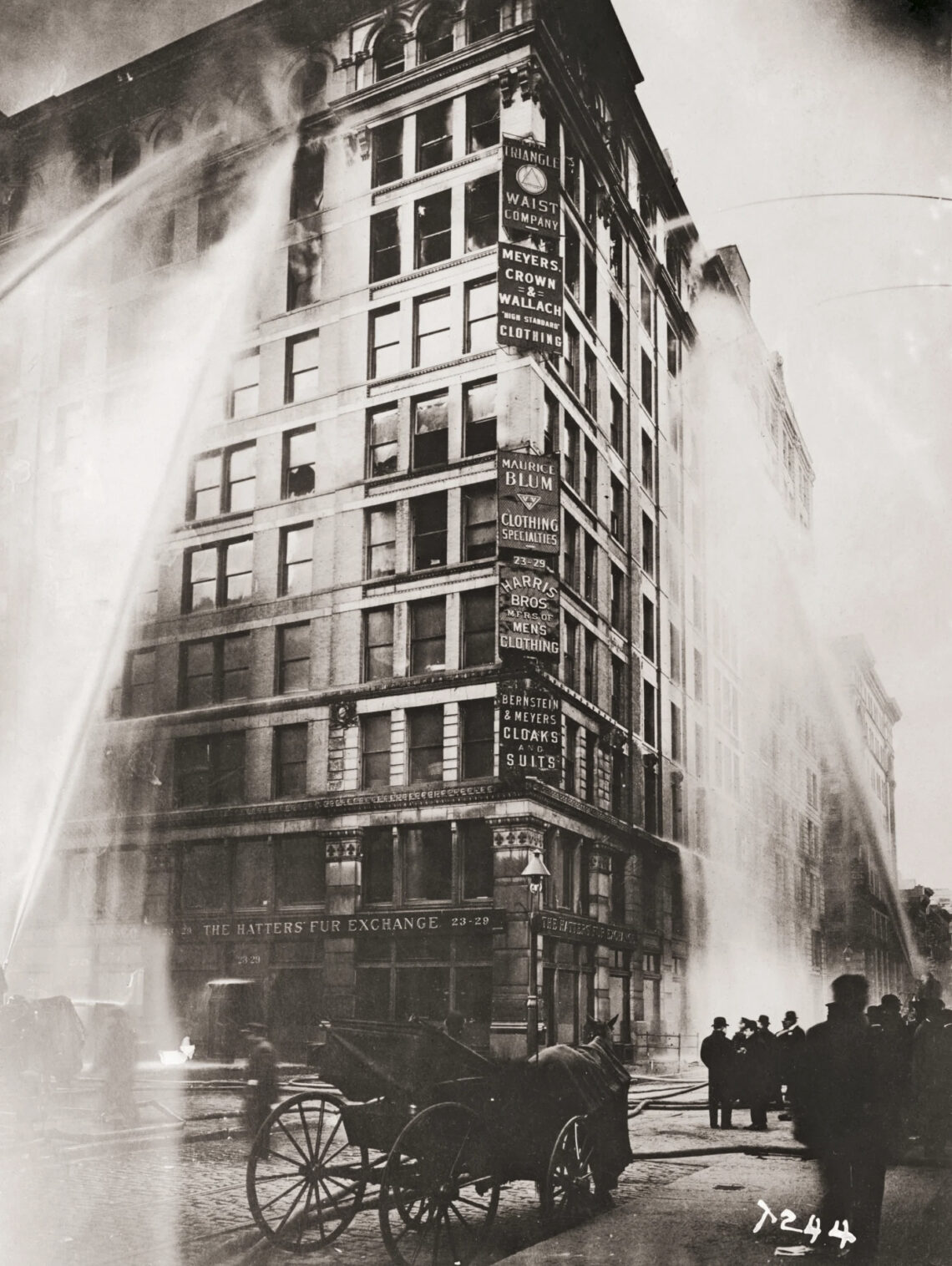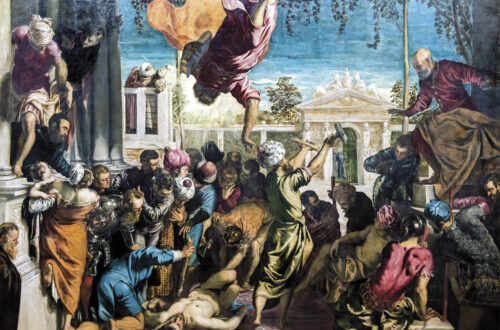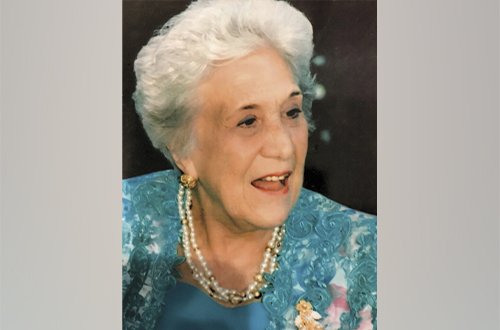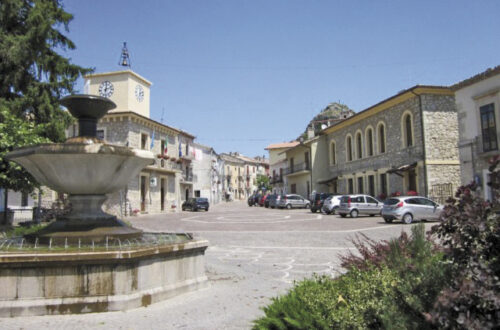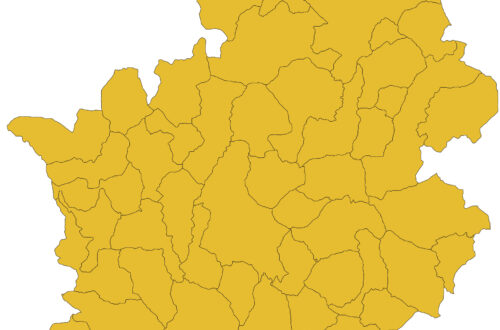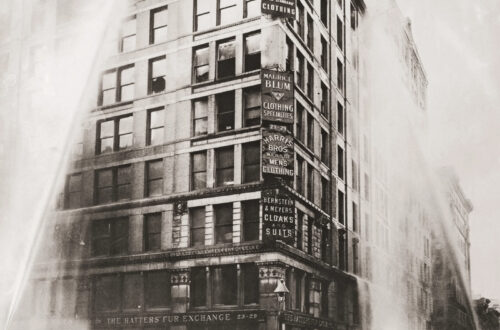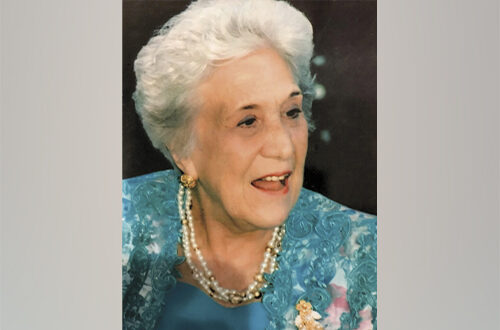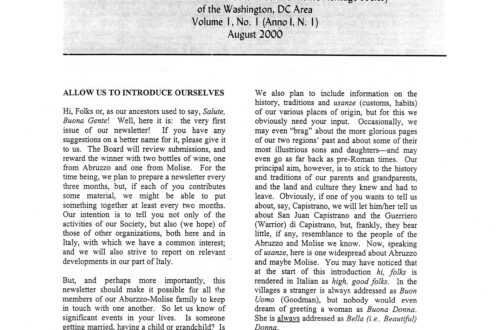-
Writer and Educator Edvige Giunta Describes Impact of Triangle Fire Tragedy
By Nancy DeSanti, 1st Vice President-Programs
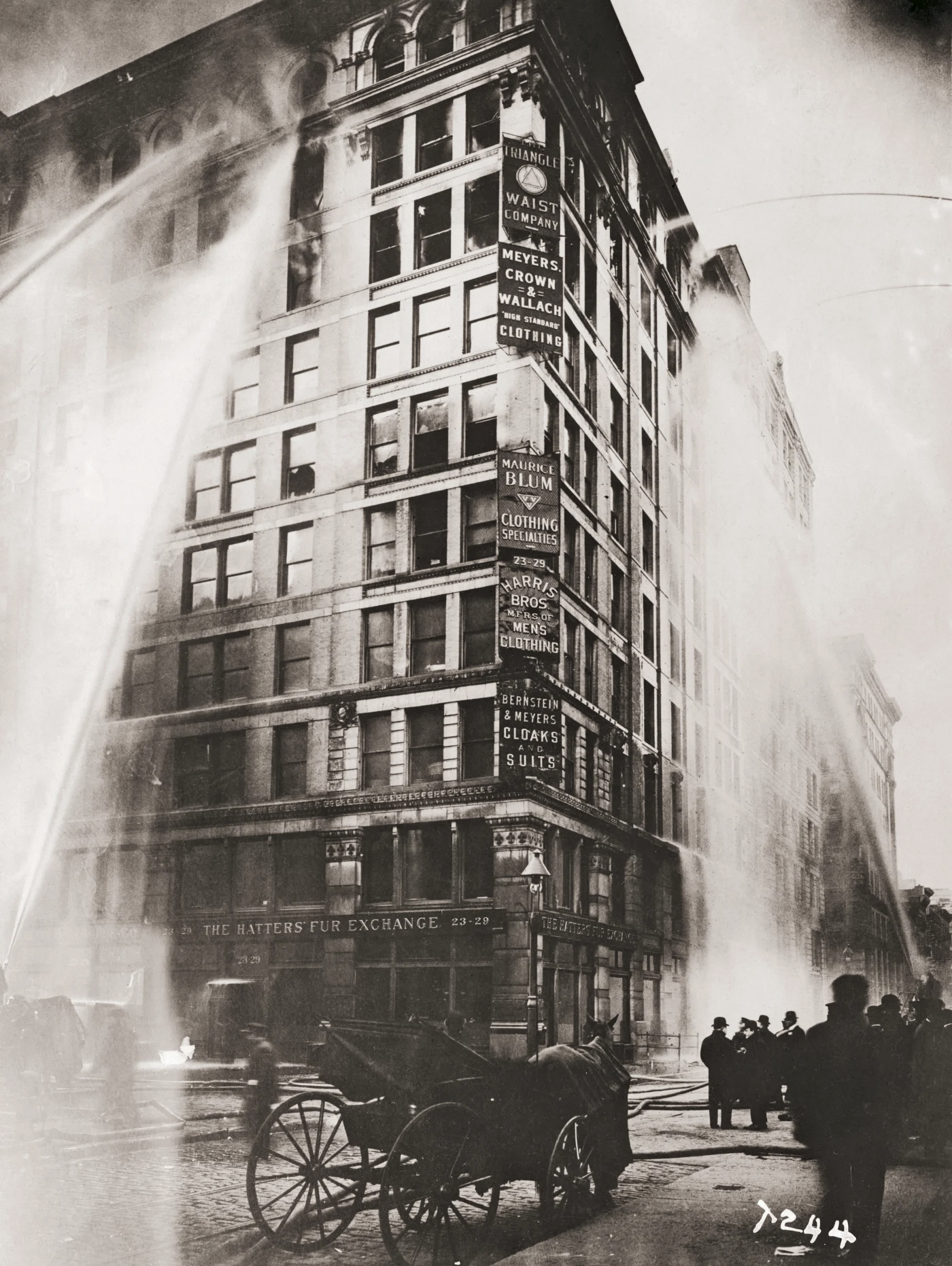
Firefighters battled the Triangle Factory blaze in vain.
Credit: History.com
Writer and educator Edvige Giunta treated AMHS members to a passionate and informative virtual program on August 27 about the impact of the Triangle Shirtwaist Factory fire of 1911 in New York City, a tragedy that touches on women’s rights, workers’ rights and immigration.
The fire killed 146 workers in a mere 15 minutes. The victims were mostly immigrants, specifically Italian and Eastern European Jewish women and girls. The fire in Greenwich Village on March 25, 1911, was the deadliest industrial disaster in the city’s history. Professor Giunta explained to us how this tragedy eventually led to laws requiring improved factory safety standards and helped spur the growth of the unions that fought for better working conditions for sweatshop workers.
Edvige’s book on the subject, co-edited with Mary Anne Trasciatti, is “Talking to the Girls: Intimate and Political Essays on the Triangle Shirtwaist Factory Fire.” She calls it a “labor of love” and “candid and intimate accounts of the tragedy that shaped American labor rights.”
This book is the first anthology on the Triangle fire, in which family members, writers, artists, teachers, and activists explore the lasting memory of the fire in their lives. Professor Giunta talked about the very personal essays by the son of Isidore Abramowitz, the man who was believed to have accidentally started the fire, and by the grandson of Frances Perkins, the woman who later became President Franklin D. Roosevelt’s Secretary of Labor, and who went on to play a key role in enacting worker safety laws, Social Security, unemployment insurance and more.
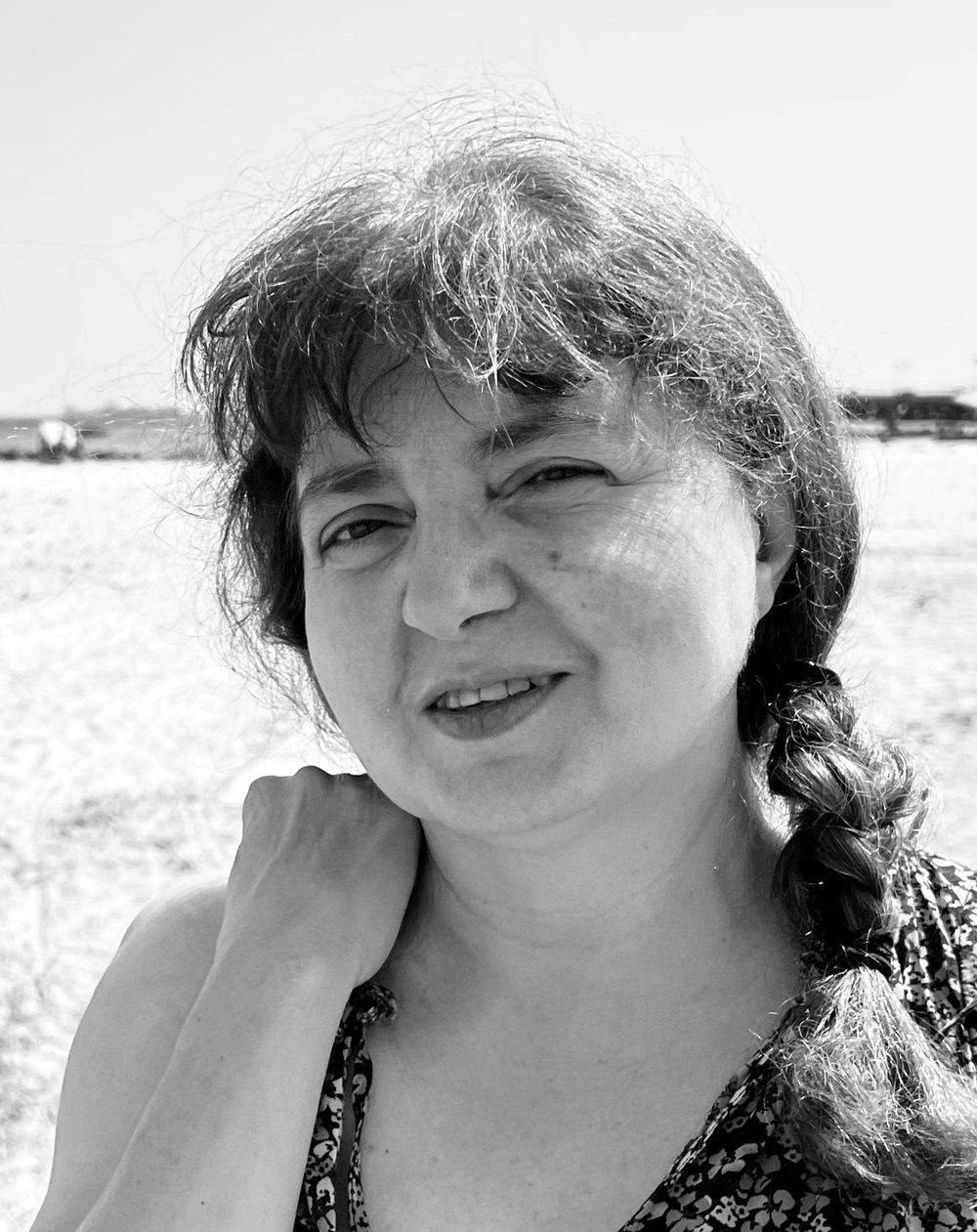
Edvige Giunta
Credit: Courtesy of Edvige GiuntaAfter noting that the victims were women and girls as young as 14, Edvige asked everyone to go to the website rememberthetrianglefire.org and pick out a name of one of the victims, and “hold it in your heart.” She said each worker had her own story, which began with a name.
Professor Giunta, who grew up in Gela, Sicily, told us that she first heard about the Triangle fire when she was a 17-year-old girl in Sicily, the same age as some of the victims. At that time, she did not know that many of the victims were Italian (at least 26 of the victims were Sicilian).
Edvige mentioned that each year on the March 25 anniversary of the fire, a ceremony is held at the Asch Building near Washington Square Park in New York City and the names of the victims are recalled. To keep the memory alive, she said next year, a permanent memorial is expected to be completed and inaugurated. As she noted, such tragedies are not all in the past, they are still occurring in parts of the world such as Bangladesh.
Edvige Giunta was born and raised in Sicily, where she studied at the University of Catania. She moved to the United States to study literature at the University of Miami, where she received an M.A. and a Ph.D. in English. She regards herself as both Italian and Italian-American, having dual citizenship and having lived in the U.S. for almost 40 years.
A regular contributor to Italian American studies, she is the author of “Writing with an Accent: Contemporary Italian American Women Authors.” She has coedited six anthologies. In Italy, she has published “Dire l’indicibile: il memoir delle autrici italo americane.” As a professor of English at New Jersey City University, she has trained scores of students, many of them first-generation immigrants, in the art of memoir and has also taught memoir for writers of all backgrounds and levels in the U.S. and Italy. She has completed “No Confetti for the Dead,” a memoir moored in the space between her homeland of Sicily and North America.
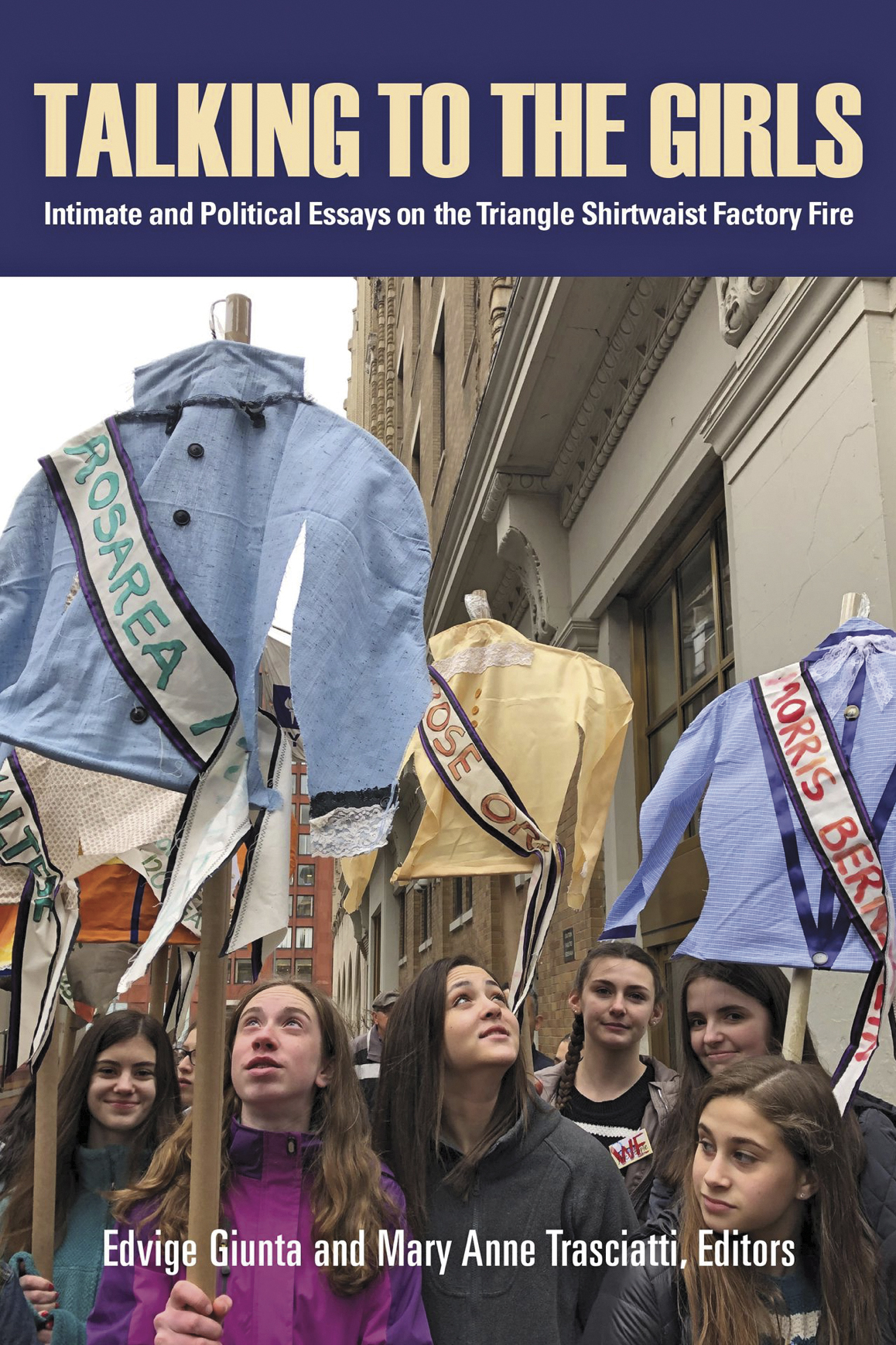
A big thank you to AMHS member Kirsten Keppel for suggesting the topic and speaker, from whom she has taken several workshops.
Edvige’s Homework Assignment
During her talk, Edvige invited participants to write something afterwards about a personal or historical memory which meant something to them. After giving it some thought, I decided to write a few words about a personal memory with some historical meaning too.
I remembered that when I was a kid, I visited the town in Italy where my father grew up, San Giorgio di Pesaro in the Le Marche region. I remember seeing the Metauro River, which is now almost dried up but which my father used to cross by donkey cart as a boy, and then learning that it was the site of what is considered by historians to be one of the 15 most decisive battles in history (the Battle of the Metaurus River during the Second Punic War, fought between the armies of Rome and Carthage in 207 B.C.).
To briefly summarize its significance—the battle was between the Roman army and the army of Hasdrubal, the brother of Hannibal of Carthage. The Roman consuls outfoxed Hasdrubal, thanks to the interception of communications between the brothers and thanks to the brilliant military strategies of the Romans. After Hasdrubal was killed in battle, his head was severed from his body, taken south, and thrown into Hannibal’s camp as a token of his brother’s defeat. The battle confirmed Roman supremacy, and without Hasdrubal’s army to support him, the demoralized, stranded Hannibal was compelled to retreat.
Even the small towns in Italy have some amazing history!!
November/December 2022
-
AMHS to Administer Angela Lastrico Raish Scholarship
By Ray LaVerghetta and Liz DiGregorio
The AMHS Scholarship will begin managing the Angela Lastrico Raish Scholarship at the end of 2022. The award, named for a prominent member of the Washington area Italian American community, will be distinct from, and in addition to, the two scholarships awarded by the Society each year.
Last year the AMHS received a proposal to manage this new award. After careful consideration, the Society’s Executive Committee voted to accept the proposal. The new scholarship, valued at $2500, will target exceptional students in the music arts field who have either an Italian background or an interest in Italy or Italian studies. Our organization will not be responsible for funding the new scholarship, whose financial support will come instead from the estate of the late Angela Lastrico Raish. Ms. Raish was a proud Italian American woman who had a great passion for music, Italy and the Italian language. She also gave great importance to encouraging young people, especially women, to pursue their dreams of excellence in the music arts field.
Our Scholarship Committee will begin managing the program at the end of this year, as the first scholarship will be awarded in the spring of 2023. The application period for the scholarship will coincide with that of our own awards: it will open on December 1 of this year and close at the end of March 2023. The winner will be announced in early May 2023. The application form, the requirements for the application process, and the eligibility criteria are currently on our website, under the scholarship tab.
Angela, who passed away earlier this year at the age of 100, had friendships with a number of AMHS members, took classes at the Casa Italiana Language School, and attended some of our AMHS events. One of her friends, Liz DiGregorio, has offered us an excellent look at her life, which we reproduce below.
About Angela Lastrico Raish
Angela Lastrico Raish was born in Ashton, Iowa, in 1921. She was one of three children born to immigrant parents from the Liguria Region of Italy. Her father ran a confectionary and ice cream store in Ashton. Italian (Genovese dialect) was spoken at home and her mother never lost her Italian accent. During the Depression, her family relocated to Sioux Falls, South Dakota, where her father opened a grocery store.
Educated by both the Franciscan and Dominican nuns, Angela developed a strong Catholic faith, superb typing and shorthand skills and a love of music, especially piano and voice.
Because Angela grew up during the Depression when money was tight, her love of music and piano playing took a back seat. College was out of reach so she signed up for “commercial school” where she learned office skills and where she took the Civil Service test that opened doors to Washington, D.C., for her.
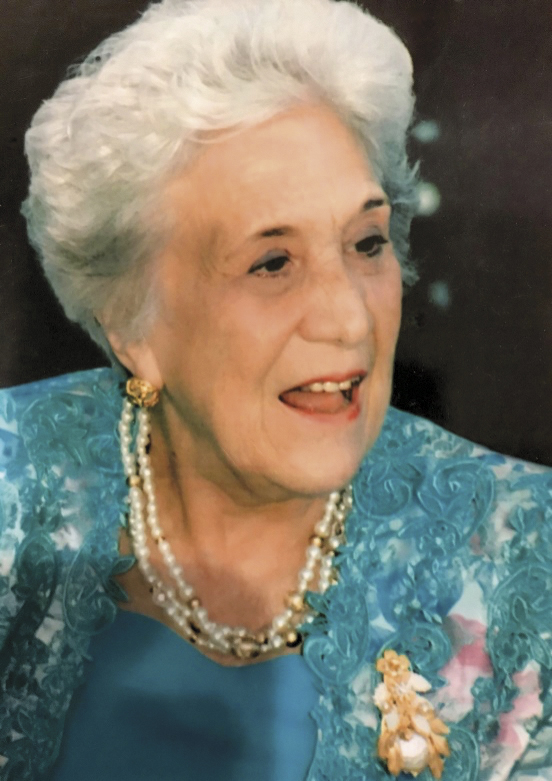
In 1942 she came to Washington, D.C., as part of the “government girls” beginning her first job with the U.S. Navy Department in Washington, D.C. She met her future husband, Bob Raish, who served in both the Atlantic and Pacific fleets during World War II. They married in 1947, had two sons, and from 1952 through 1967 lived in London and Paris.
Her professional career began in the late 1960’s. She worked tirelessly behind the scenes for people whose names read like a “who’s who” of Washington politics. Her career took her to the National Republican Committee; the Office of Senator Bob Dole; the White House, Counsellor to the President; and for 20 years, confidant, personal secretary, scheduler and constituent liaison to Senator Pete V. Domenici of New Mexico. She was viewed by all as “il braccio destro” (the right-hand man) of whoever she worked for.
Angela never lost her love for Italy, the Italian language or music. She studied Italian at Casa Italiana in Washington, D.C., kept in touch in Italian with family in Camogli (Liguria), and always, always had music in her life. Season tickets to the Alexandria Symphony and opera tickets at the Kennedy Center were a must. When she moved to Goodwin House Residential Care in 2012, her volunteer job was singing to the residents in the Alzheimer unit every Saturday afternoon. As she often remarked, “Music is for everyone, it is a language we can all understand. It lifts the soul.” Angela passed away on June 3, 2022.
November/December 2022
-
Sepino, Province of Campobasso, Region of Molise

By Nancy DeSanti
Province of Campobasso, Region of Molise
The town of Sepino. located 20 kilometers south of Campobasso, is home to some important Roman ruins and considered one of the most extraordinary archeological sites of central Italy where excavations began in the early 1950s. It has approximately 1,915 inhabitants, known as Sepinesi. The town was rated among the “borghi piu belli d’Italia“(most beautiful towns in Italy).
Sepino rises at the foot of the Matese Massif, on the Molise Appennine. The Matese is one of the most ancient European mountains. There is a mountain spring of water which is collected nowadays and sold as “Sepinia” in the area now called Tre Fontane. The prehistoric site called Terravecchia was the refuge of the first shepherds, who during the Bronze Age climbed up to drink from the springs in the Matese. The town developed when rich Roman imperial families came to enjoy the healthy water. Not very far from the spring, the most intact dinosaur in Italy was found.
The current town of Sepino was founded when the inhabitants of Saepinum decided that their town on the plain was too vulnerable and moved up the mountain in the 8th century to build a new town, which became Sepino. The remains of the Roman town of Saepinum and also of the older Samnite town of Saepins attract many visitors.
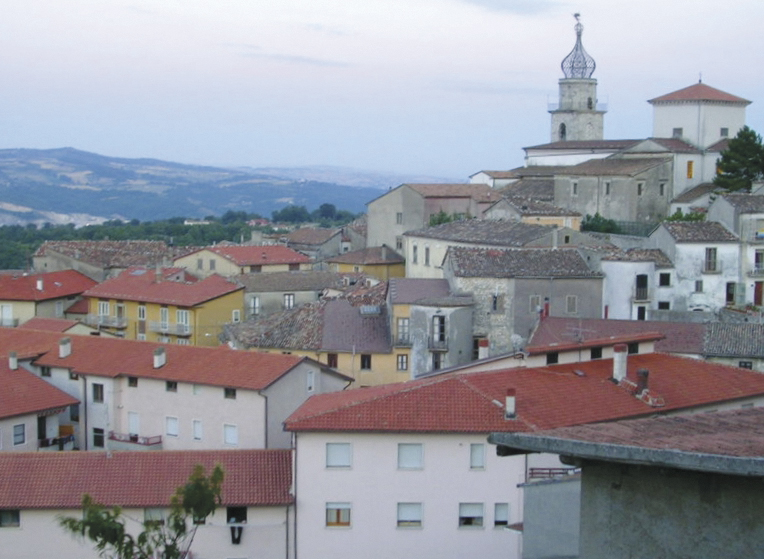
A view of Sepino.
Credit: WikipediaAfter the decline of the Roman town of Saepinum following an earthquake, general economic problems and then the Greek-Gothic wars, the town passed to control of the Lombard dukes and then to a Bulgarian colony. The Bulgars were for many generations a distinctive part of the population, until finally assimilating into their Italian environment.
The town of Sepino has at its heart the Church of Santa Cristina with a beautiful belltower topped by an intricate metal spire in the shape of an onion. The church dominates views of the village from the plains below. Inside the church, the chapels contain treasures including reliquaries, a walnut door carved in the early 17th century, a carved choir loft and 12th century scrolls.
By the 15th century Sepino was a flourishing center, among the 10 most important in Molise. But by the beginning in the late 19th century, many residents of Sepino had begun immigrating to other countries. The earliest waves immigrated to the United States, particularly Hartford, Conn., and to Argentina. After World War II, the immigration to other countries accelerated.
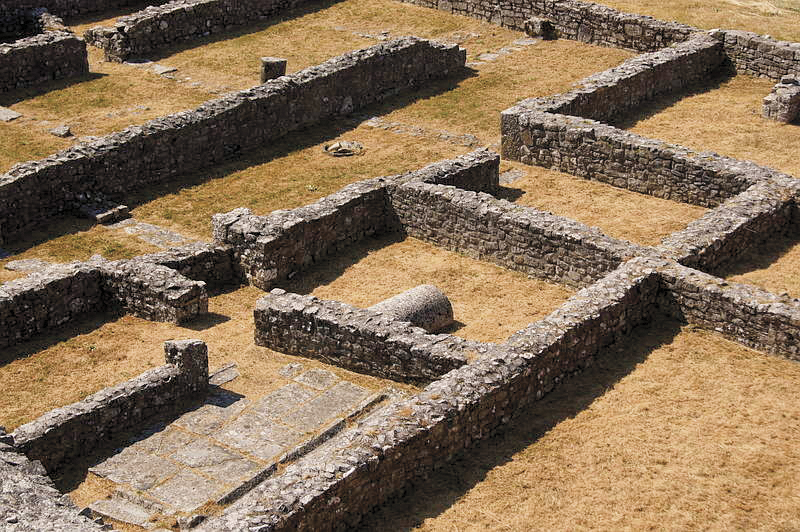
Part of the roman ruins in the ancient part of town.
Credit: italythisway.comWhat to See
- Archeological site of the Roman town Saepinum, inhabited up to the 4th century AD
- Archeological site of the Samnite town Saepins in Torrevecchia, of the 4th century BC, including a fortress with 3 entrance doors and an acropolis inside which was possibly the seat of the Samnite ruler
- Tre Fontane springs, whose water is used for kidney problems.
- Church of Santa Cristina
Italiano

Tradotto da Ennio Di Tullio
Provincia di Campobasso, Regione Molise
Il comune di Sepino. situato a 20 chilometri a sud di Campobasso, ospita importanti resti romani ed è considerato uno dei più straordinari siti archeologici dell’Italia centrale dove gli scavi iniziarono nei primi anni ’50. Conta circa 1.915 abitanti, conosciuti come Sepinesi. Il paese fu annoverato tra i “borghi piu belli d’Italia”.
Sepino sorge ai piedi del Massiccio del Matese, sull’Appennino molisano. Il Matese è una delle montagne più antiche d’Europa. C’è una sorgente d’acqua di montagna che oggi viene raccolta e venduta come “Sepinia” nella zona oggi denominata Tre Fontane. Il sito preistorico denominato Terravecchia fu rifugio dei primi pastori, che nell’età del Bronzo salirono ad abbeverarsi alle sorgenti del Matese. La città si sviluppò quando le ricche famiglie imperiali romane vennero a godersi l’acqua sana. Non molto lontano dalla sorgente è stato ritrovato il dinosauro più intatto d’Italia.
L’attuale comune di Sepino nasce quando gli abitanti di Saepinum decisero che il loro paese di pianura era troppo vulnerabile e si spostarono sulla montagna nell’VIII secolo per costruire un nuovo centro, che divenne Sepino. I resti della città romana di Saepinum e anche della più antica città sannita di Saepins attirano molti visitatori.
Dopo la decadenza della città romana di Saepinum a seguito di un terremoto, di problemi economici generali e poi delle guerre greco-gotiche, la città passò al controllo dei duchi longobardi e poi a una colonia bulgara. I Bulgari furono per molte generazioni una parte distintiva della popolazione, fino ad assimilare definitivamente all’ambiente italiano.
Il paese di Sepino ha al centro la Chiesa di Santa Cristina con un bel campanile sormontato da un’intricata guglia metallica a forma di cipolla. La chiesa domina le vedute del paese dalla pianura sottostante. All’interno della chiesa, le cappelle custodiscono tesori tra cui reliquiari, una porta in noce scolpita all’inizio del XVII secolo, un coro scolpito e pergamene del XII secolo.
Nel XV secolo Sepino era un fiorente centro, tra i 10 più importanti del Molise. Ma all’inizio, alla fine del XIX secolo, molti residenti di Sepino avevano iniziato a immigrare in altri paesi. Le prime ondate migrarono negli Stati Uniti, in particolare Hartford, Conn., e in Argentina. Dopo la seconda guerra mondiale, l’immigrazione verso altri paesi accelerò.
Le attrazioni del luogo:
- Sito archeologico della città romana Saepinum, abitata fino al IV secolo dC
- Sito archeologico della città sannita Saepins a Torrevecchia, del IV secolo aC, comprendente una fortezza con 3 porte d’ingresso e un’acropoli all’interno della quale forse fu sede del sovrano sannita
- Le sorgenti delle Tre Fontane, le cui acque vengono utilizzate per problemi ai reni.
- Chiesa di Santa Cristina
November/December 2022
-
Acciano, Province of L’Aquila, Region of Abruzzo

By Nancy DeSanti
Province of L’Aquila, Region of Abruzzo
The small town of Acciano is located in the province of L’Aquila in the Subequana valley and is a part of the Sirentina Mountain community. It is well known in Italy for its quality production of Montepulciano red wines at reasonable prices. This small medieval town has approximately 337 inhabitants, known as Accianesi.
Situated on a high mountain crest along the Aterno valley, in the beautiful Valle Subequana, the municipality includes also the frazioni Beffi, Succiano and Roccapreturo.
Surrounded by green woods of oak trees, Acciano is perched on a spur of rock between the mountains, offering a beautiful view of the rocky ridges of Sirente.
As a reminder of its Lombard origin, Acciano still maintains the layout of a fortified borough with three doors — Porta Torrone, Porta Martino and Porta of Aia. In the 14th century, it was ruled by Matteo Gentile, then until the late 18th century it belonged to the Piccolominis. It seems the name may derive from a Roman landowner named Accius.
What to See
- Church of St. Petronilla
- Church of Sts. Pietro and Lorenzo from the 16th century
- 15th century Fountain
- Roccapreturo tower and medieval fortified remains
- Beffi sighting towers and the medieval village
Important Dates
- Pentecost Monday-Tuesday – Festivity of the Madonna della Valle
- May 30-31 – Feast of St. Petronilla, the patron saint
- 1st Sunday in June – Feast of St. Erasmo, with a procession on Monte Offermo
- July 29-31 – Sagra of arrosticini, truffle and wine
- 1st Sunday in November – Fair at Beffi
Italiano

Tradotto da Ennio Di Tullio
Provincia di L’Aquila, Regione Abruzzo
Il piccolo comune di Acciano si trova in provincia dell’Aquila nella valle Subequana e fa parte della Comunità Montana Sirentina. È ben noto in Italia per la sua produzione di qualità di vini rossi Montepulciano a prezzi ragionevoli. Questo piccolo paese medioevale conta circa 337 abitanti, conosciuti come Accianesi.
Situato su un’alta cresta montuosa lungo la valle dell’Aterno, nella bellissima Valle Subequana, il comune comprende anche le frazioni Beffi, Succiano e Roccapreturo.
Circondato dal verde dei boschi di querce, Acciano è arroccato su uno sperone di roccia tra le montagne, offrendo una bellissima vista sui costoni rocciosi del Sirente.
A ricordo della sua origine longobarda, Acciano conserva ancora l’impianto di borgo fortificato a tre porte — Porta Torrone, Porta Martino e Porta dell’Aia. Nel 1300 fu governata da Matteo Gentile, poi fino alla fine del 1700 appartenne ai Piccolomini. Sembra che il nome derivi da un proprietario terriero romano di nome Accius.
Le attrazioni del luogo:
- Chiesa di S. Petronilla
- Chiesa dei SS. Pietro e Lorenzo del XVI sec
- Fontana del XV secolo
- Torre Roccapreturo e resti fortificati medievali
- Torri di avvistamento Beffi e il borgo medievale
Date da ricordare:
- Lunedì-Martedì di Pentecoste – Festa della Madonna della Valle
- 30-31 maggio – Festa di S. Petronilla, patrona
- 1° domenica di giugno – Festa di S. Erasmo, con processione sul Monte Offermo
- 29-31 luglio – Sagra di arrosticini, tartufo e vino
- 1° domenica di novembre – Fiera a Beffi
November/December 2022
-
Siamo Una Famiglia

AMHS Members Tour Baseball Exhibit at Postal Museum
A group of AMHS members enjoyed a private tour of the special exhibit Baseball: America’s Home Run at the National Postal Museum on October 2 led by the museum’s Chief Curator Daniel A. Piazza.
The exhibit features stamps and artifacts including those of Joe DiMaggio, Roy Campanella and Yogi Berra, as well as a treasure trove of historically significant game-worn uniforms, jackets, hats, game-used bats, and memorabilia from “America’s pastime.” Joe DiMaggio’s 1941 contract is on display. In the year after The Yankee Clipper set his still unmatched record of hitting in 56 straight games, his immigrant father’s fishing boat was confiscated because the elder DiMaggio was not a U.S. citizen and due to the crackdown by the federal government on Italians working in coastal areas. Dan showed the group not only the baseball exhibit but much more too, sharing his extensive knowledge of postal history, the museum and Italian stamps. He recounted that Charles Ponzi’s famous Ponzi scheme involved the postal service.
Dan had given a well received online presentation to the AMHS on July 31 on the history of Italian stamps during the Fascist period. The Society thanks him for his generosity in sharing his time on his day off to guide the tour.

AMHS Board Member, Joseph (Sonny) Scafetta, Jr., gives a 2023 Italian-American stamp calendar to Dan Piazza, Chief Curator of the National Postal Museum, in Washington, D.C.
Credit: Nancy DeSantiAMHS Wreath Presented at Columbus Day Ceremony
AMHS Member Wins
Beautiful Vespa at Raduno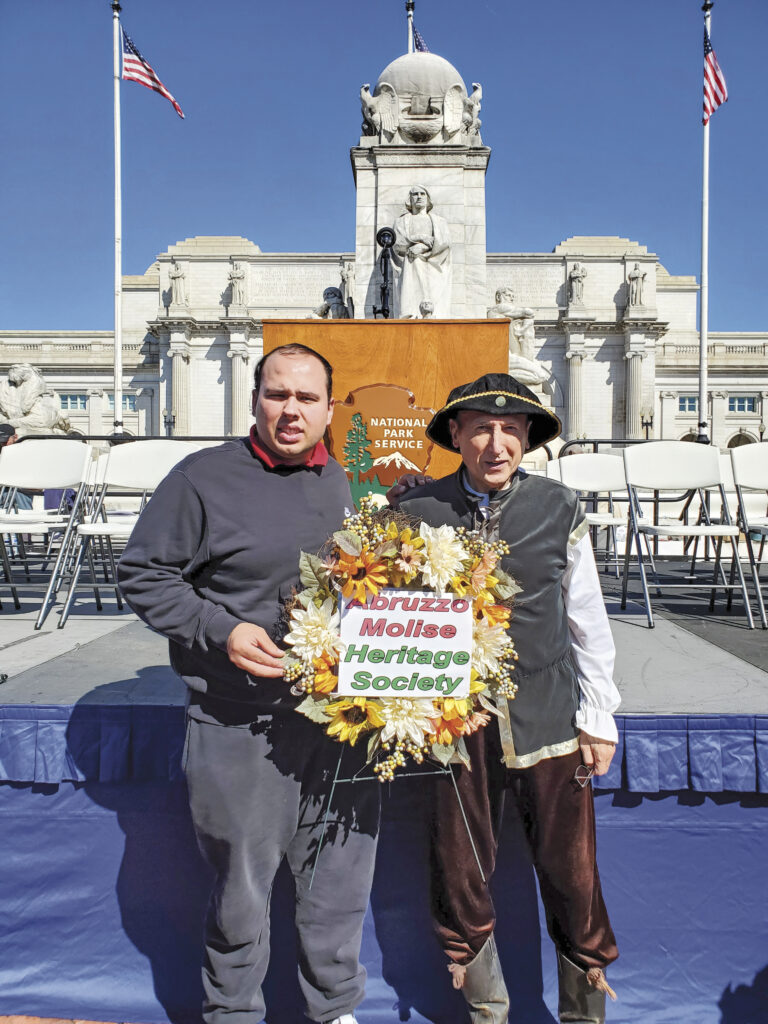
Board Member Joseph Scafetta, Jr. (right) and his son, Joseph Scafetta III, also an AMHS member, presented a wreath on behalf of the AMHS at the Columbus Day ceremony in front of Washington’s Union Station on October 10, 2022.
Credit: Teresa Margaret Talierco
AMHS member Eileen Parise was the lucky winner of a beautiful red classic Vespa ET2 at this year’s Raduno held by the Vespa Committee of Washington. The annual event took place on September 17, starting at the Italian embassy and running to many of the city’s major attractions.
Credit: Courtesy of Willy MeauxPassing of AMHS Member Betsy Ruzzi
We regret to inform you that one of our long-time members, Betsy Sara Brown Ruzzi, of Arnold, Md., passed away on October 12, 2022, after a long bout with cancer. She is survived by her beloved husband, Joseph Ruzzi, Jr., and children Michael Jacob Ruzzi and Sara Joyce Ruzzi. AMHS members will recall that Betsy’s husband Joe has been a frequent participant at our annual wine-tasting events. The Ruzzi family, including AMHS members Joe Sr. and his wife Rose, have been longtime parishioners of Holy Rosary Church and members of the Casa Italiana community. Our sincerest condolences to the family.
AMHS Membership
A warm welcome is extended to: Judy Damiani and Stephanie Salvagno Frye.
Birthdays Compleanni a Novembre
Eileen Verna and Naomi Leiobold, November 1; Rev. John V. DiBacco, Jr., November 2; Richard Durkin, November 3; Rita Carrier and Michael DeBonis, November 4; Elena Biondi and Christopher Anthony DiPaolo, November 5; Luciana Caleb and Sergio Fresco, November 8; Rocco Caniglia and Joe Ruzzi, Jr., November 9; Michael McDonald, November 10; Emilia DeMeo, November 12; Cara Cavicchia Walker, November 15; Edvige D’Andrea, Joseph D’Andrea, Dena DeBonis and Sabrina de Sousa, November 19; William DiGiovanni, November 21; Gerard Di Flavis, November 24; Christina Iovino, November 25; Norma Phillips, November 29; and Amelia DiFiore, November 30.Compleanni a Dicembre
Rosalie Ciccotelli, December 2; Domenica Marchetti, December 3; Alfred DelGrosso, December 4; Marlene Lucian and Louie Anne D’Ottavio, December 6; Yoni Kay Caniglia, December 7; Frank Bonsiero, December 8; Stephen di Girolamo, December 9; Stephanie Salvagno Frye, December 10; Donna DeBlasio, December 11; William Lepore and Barbara Gentile, December 12; Maria D’Andrea-Yothers, December 13; Cathy Branciaroli, December 16; Domenico Conti, December 18; Elodia D’Onofrio and Carmine James Spellane, December 20; Anna Isgro, December 21; Claire DeMarco, December 22; Brian Pasquino, December 25; Michael Savino, December 26; and Margot DeRuvo Gilberg, December 29.Anniversaries Anniversari a Novembre
Harry & Joan Piccariello, November 9; Joseph & Rose Ruzzi, November 19.Anniversari a Dicembre
Ray & Michele LaVerghetta, December 11; and David & Cristina Scalzitti, December 27.Membership Information Category # of Persons
Associate (Couple): 3 x 2 = 6
Associate (Individual): 40
General (Couple): 50 x 2 = 100
General (Individual): 91
Honorary: 10
Scholarship: 2
Student: 7
Total Membership: 256November/December 2022
